Flora of Australia
| Part of a series on |
| Wildlife of Australia |
|---|
 |
The flora of
The arrival of humans around 50,000 years ago
Origins and history
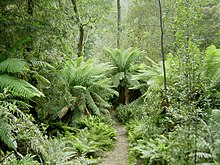
Australia was part of the southern supercontinent Gondwana, which also included South America, Africa, India and Antarctica. Most of the modern Australian flora had their origin in Gondwana during the Cretaceous when Australia was covered in subtropical rainforest. Australian ferns and gymnosperms bear a strong resemblance to their Gondwanan ancestors,[4] and prominent members of the early Gondwanan angiosperm flora such as the Nothofagus, Myrtaceae and Proteaceae were also present in Australia.[5]
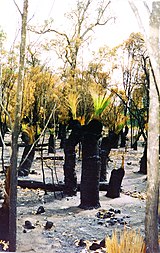
Gondwana began to break up 140 million years ago (MYA); 50 MYA during the
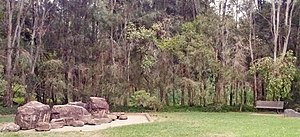
The development of aridity and the old and nutrient poor soils of the continent led to some unique adaptations in the Australian flora and evolutionary radiation of genera – like carbon fixation which reduce water loss during photosynthesis are two common adaptations in Australian arid-adapted dicot and monocot species respectively.
Rising aridity also increased the frequency of fires in Australia. Fire is thought to have played a role in the development and distribution of fire-adapted species from the Late Pleistocene. An increase in charcoal in sediment around 38,000 years ago coincides with dates for the inhabitation of Australia by the Indigenous Australians and suggests that man-made fires, from practices like fire-stick farming, have played an important role in the establishment and maintenance of sclerophyll forest, especially on the east coast of Australia.[8] Adaptations to fire include lignotubers and epicormic buds in Eucalyptus and Banksia species that allow fast regeneration following fire. Some genera also exhibit serotiny, the release of seed only in response to heat and/or smoke. Xanthorrhoea grass trees and some species of orchids only flower after fire.[9]
Biogeography
In biogeography and zoogeography, Australia alone is sometimes considered a realm (Australian realm), while some authors unite the area with other regions to form the Australasian realm.
In phytogeography, the area is considered a floristic kingdom (Australian kingdom), with the following endemic families, according to Takhtajan: Platyzomataceae (now included in
Vegetation types

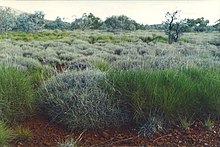
Australia's terrestrial flora can be collected into characteristic
According to the scheme the most common vegetation types are those that are adapted to arid conditions where the area has not been significantly reduced by human activities such as land clearing for agriculture. The dominant vegetation type in Australia is the hummock grasslands that occur extensively in arid Western Australia, South Australia and the Northern Territory. It accounts for 23% of the native vegetation, the predominant species of which are from the genus
A further 39% of native vegetation is covered by a combination of:
- Eucalypt woodlands found at the transition between hummock grasslands and higher rainfall areas where conditions still limit tree growth; the woodland may have a grass or shrubby understory. The largest area is in Queensland.
- Acacia forests and woodlands that occur in semi-arid areas where tree growth is stunted.[15] The dominant Acacia species varies with the location, and may include lancewood, bendee, mulga, gidgee and brigalow. The largest area is in Western Australia.[16]
- Acacia shrublands in semi arid and arid regions. The most common are mulga shrublands; the largest area is in Western Australia.
- Tussock grasslands that occur in semi-arid and some temperate [clarification needed] parts of Australia; they host a large variety of grasses from more than 10 genera. The largest area is in Queensland.
- Chenopod/samphire shrubs and forblands that are widespread in the near-estuarine, arid and semi-arid areas. Species in chenopod communities are drought and Sclerostegia and Sarcocornia. Both South and Western Australia have large areas with this vegetation type.
Other groups with restricted areas of less than 70,000 square kilometres include tropical or temperate rainforest and vine thickets, tall or open eucalypt forests, Callitris and Casuarina forests, and woodlands and heath.
Vascular plants
Australia has over 21,077 described species of vascular plants,
At the higher taxonomic levels the Australian flora is similar to that of the rest of the world; most vascular plant families are represented within the native flora, with the exception of the cacti, birch and a few others, while 9 families occur only in Australia.[21][22] Australia's vascular flora is estimated to be 85% endemic;[23] this high level of vascular plant endemism is largely attributable to the radiation of some families like the Proteaceae, Myrtaceae, and Fabaceae.
Angiosperms
| Family | % of total flora1 | Notable genera |
|---|---|---|
| Fabaceae | 12.0 | Acacia, Pultenaea, Daviesia, Bossiaea |
| Myrtaceae | 9.3 | Callistemon, Eucalyptus, Melaleuca, Leptospermum |
| Asteraceae | 8.0 | Brachyscome, Olearia |
| Poaceae | 6.5 | Triodia |
| Proteaceae | 5.6 | Banksia, Hakea, Grevillea |
| Cyperaceae | 3.3 | Cyperus |
Orchidaceae
|
3.0 | Caladenia, Pterostylis |
| Ericaceae | 2.1 | Leucopogon, Epacris |
| Euphorbiaceae | 2.0 | Ricinocarpos |
| Rutaceae | 1.8 | Boronia, Correa, Citrus |
| 1 Based on total number of species | ||
The native Australian flora contains many
Other families with well-known representatives include the alpine Tasmanian button grass, which form tussock-like mounds from the Cyperaceae; the genus Patersonia of temperate iris-like forbs from the Iridaceae; and, the kangaroo paws from the family Haemodoraceae. The Xanthorrhoea grass trees, the screw palms of the Pandanaceae and palms are large monocots present in Australia. There are about 57 native palms; 79% of these only occur in Australia.[25]
The
Many plant families that occur in Australia are known for their floral displays that follow seasonal rains. The Asteraceae is well represented by its subfamily Gnaphalieae, which included the paper or everlasting daisies; this group has its greatest diversity in Australia. Other families with flowering shrubs include the Rutaceae, with the fragrant Boronia and Eriostemon, the Myoporaceae with the Eremophila, and members of the Ericaceae with Victoria's Floral Emblem Epacris impressa.
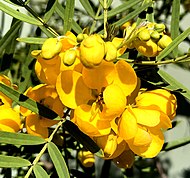
Amongst the most ancient species of flowering hardwood trees are the
Australia's salt marshes and wetlands are covered by a large variety of salt and drought tolerant species from the
Aquatic monocots and dicots both occur in Australian waters. Australia has about 51,000 square kilometres of
Gymnosperms
Ferns and fern allies
Spore bearing vascular plants include the ferns and fern allies. True ferns are found over most of the country and are most abundant in tropical and subtropical areas with high rainfall. Australia has a native flora of 30 families, 103 genera and 390 species of ferns, with another 10 species being naturalised. The "fern allies" are represented by 44 native species of whisk ferns, horsetails and lycophytes.[28] Ferns prefer a cool and damp environment since water is required for reproduction, the majority of Australian species are found in bushland [clarification needed] and rainforest, there are aquatic, epiphytic (Platycerium, Huperzia and Asplenium), and terrestrial species including large tree ferns from the genera Cyathea and Dicksonia.
Non-vascular plants
The algae are a large and diverse group of photosynthetic organisms. Many studies of algae include the cyanobacteria, in addition to micro and macro eukaryotic types that inhabit both fresh and saltwater. Currently, about 10,000 to 12,000 species of algae are known for Australia.[29] The algal flora of Australia is unevenly documented: northern Australia remains largely uncollected for seaweeds and marine phytoplankton, descriptions of freshwater algae are patchy, and the collection of terrestrial algae has been almost completely neglected.[30]
The
Fungi
The fungal flora of Australia is not well characterised; Australia is estimated to have about 250,000 fungal species of which roughly 5% have been described. Knowledge of distribution, substrates and habitats is poor for most species, with the exception of common plant pathogens.[33]
Lichens
Lichens are composite organisms comprising, in most cases, an Ascomycete fungus and a unicellular green alga, their classification is based on the type of fungi. The lichen flora of Australia and its island territories, including Christmas Island, Heard Island, Macquarie Island and Norfolk Island, currently comprises 3,238 species and infra-specific taxa in 422 genera, 34% of which are considered to be endemic.[34]
Use by humans

The first Australian plants recognised and classified in Linnaean taxonomy were a species of Acacia and Synaphea in 1768 as Adiantum truncatum and Polypodium spinulosum respectively by Dutch philologist Pieter Burman the Younger, who stated they were from Java. Later, both were found to be from Western Australia, likely to have been collected near the Swan River, possibly on a 1697 visit there of fellow Dutchman Willem de Vlamingh.[35] This was followed by Cook's expedition making landfall at what is now Botany Bay in April 1770, and the early work of Banks, Solander and Parkinson.[who?] Botanical exploration was enabled by the founding of the permanent colony at Port Jackson in 1788, and the subsequent expeditions along Australia's coastline.[35]
The Australian flora was utilised by the Indigenous inhabitants of Australia. Indigenous Australians used thousands of species for food, medicine, shelter, tools and weapons.[36] For example, the starchy roots of Clematis microphylla were used in western Victoria to make a dough that was baked, and the leaves of the plant were used as a poultice applied to skin irritations and blisters.[37]
Since European colonisation
Forestry species include a number of eucalypts used for paper and timber,
]Commercial use
Until recently the
Conservation
Modification of the Australian environment by Indigenous Australians and following European settlement has affected the extent and the distribution of the flora.
Threats
The changes since 1788 have been rapid and significant: displacement of Indigenous Australians disrupted fire régimes that had been in place for thousands of years; forestry practices have modified the structure of native forests; wetlands have been filled in; and broad scale land-clearing for crops, grazing and urban development has reduced native vegetation cover and led to landscape salinisation, increased sediment, nutrient and salt loads in rivers and streams, loss of habitat and a decline in biodiversity.[40] The intentional and unintentional release of invasive plant and animal species into delicate ecosystems is a major threat to floral biodiversity; 20 introduced species have been declared Weeds of National Significance.[41]
Threatened plant biodiversity
As of 2006, 61 plant species were known to have become extinct since European settlement; and a further 1,239 species were considered threatened.[42]
Protected areas
Protected areas have been created in every state and territory to protect and preserve the country's unique ecosystems. These protected areas include national parks and other reserves, as well as 64 wetlands registered under the Ramsar Convention and 16 World Heritage Sites. As of 2002, 10.8% (774,619.51 km2) of the total land area of Australia is within protected areas.[43] Protected marine zones have been created in many areas to preserve marine biodiversity; as of 2002, these areas cover about 7% (646,000 km2) of Australia's marine jurisdiction.[44]
Biodiversity hotspots
In 2003, the Australian Government's Threatened Species Scientific Committee identified 15
See also
- List of electronic floras
- List of Australian floral emblems
- List of extinct flora of Australia
- List of flora on stamps of Australia
- List of threatened flora of Australia
- Systematic Census of Australian Plants
Region specific articles
- Flora of the Australian Capital Territory
- Flora of Western Australia
- List of Nature Conservation Act endangered flora of Queensland
- List of Nature Conservation Act extinct in the wild flora of Queensland
- List of Nature Conservation Act rare flora of Queensland
- List of Nature Conservation Act vulnerable flora of Queensland
References
Notes
- PMID 21326225.
- PMID 21940856.
- ISBN 1-876622-50-4
- ^ Page, C. N. and Clifford, H. T. 1981. Ecological biogeography of Australian conifers and ferns. In A. Keast Ecological Biogeography of Australia. W. Junk
- .
- ISBN 0-909209-62-6
- PMID 15519972.
- ^ Singh, G. et al. 1981. Quaternary vegetation and fire history in Australia. In A. M. Gill, R. A. Groves and I. R. Nobel. Fire and the Australian Biota. Australian Academy of Science, 23-54
- ^ Gill, A. M. 1981. Adaptive responses of Australian vascular plant species to fire. In A. M. Gill, R. H. Groves, and I. R. Noble. eds. Fire and the Australian Biota. Australian Academy of Science
- ^ Тахтаджян А. Л. Флористические области Земли / Академия наук СССР. Ботанический институт им. В. Л. Комарова. — Л.: Наука, Ленинградское отделение, 1978. — 247 с. — 4000 экз. DjVu, Google Books.
- ^ Takhtajan, A. (1986). Floristic Regions of the World. (translated by T.J. Crovello & A. Cronquist). University of California Press, Berkeley, PDF, DjVu.
- ^ Groves, R. H. 1999. Present vegetation types. In A. E. Orchard, ed. Flora of Australia - Volume 1, 2nd edition pp 369-401. ABRS/CSIRO
- Government of Australia
- ^ NVIS 6.0 Major Vegetation Subgroups (numeric order), Department of Climate Change, Energy, the Environment and Water, Government of Australia.
- ^ Australian National Botanic Gardens (2012). "Acacia Forests and Woodlands". Retrieved 20 January 2018.
- ^ Australian Government. Department of the Environment and Energy (2017). "NVIS Fact sheet. MVG 6 – Acacia forests and woodlands" (PDF). p. 4. Retrieved 20 January 2018.
- PMID 36913725.
- ^ a b Orchard, A. E. 1999. Introduction. In A. E. Orchard, ed. Flora of Australia - Volume 1, 2nd edition pp 1-9. ABRS/CSIRO
- ISBN 0-644-11606-4
- ^ Australian Biological Resources Study. Flora of Australia Online - What's published and online, contributors and dates of publication Archived 2006-12-14 at the Wayback Machine
- ^ Crisp, M. D., West, J. G., and Linder, H.P. 1999. Biogeography of the Australian flora. In A. E. Orchard, ed. Flora of Australia - Volume 1, 2nd edition pp 321-367. ABRS/CSIRO
- ^ Department of the Environment and Heritage. Australia's Biodiversity: an overview of selected significant components Archived 2006-09-06 at the Wayback Machine, Biodiversity Series, Paper No. 2
- ^ ESD Working Group on Biological Diversity. 1991. The Conservation of Biological Diversity as it Relates to Ecologically Sustainable Development, Report of Working Party to the Ecologically Sustainable Development Secretariat, Canberra.
- Association of Societies for Growing Australian Plants
- ISBN 0-7301-0007-3
- ^ CSIRO. 2000. About Australian Seagrasses Archived 2007-04-12 at the Wayback Machine
- ^ Robertson, A.I. and Alongi, D.M. 1995. Mangrove ecosystems in Australia: structure , function and status in D.P. Larr ed Our Sea, Our Future
Major findings of the State of the Marine Environment Report for Australia Department of the Environment, Sport and Territories ISBN 0-642-17391-5
- ^ ISBN 0-643-05972-5
- ^ Australian Biological Resources Study. Algae of Australia Archived 2006-07-17 at the Wayback Machine
- doi:10.1071/sb97006.
- doi:10.1071/sb04014.
- ^ McCarthy, P.M. 2006. Checklist of Australian Liverworts and Hornworts. Australian Biological Resources Study, Canberra. Version 6.
- doi:10.1071/sb00013.
- ^ McCarthy, P.M. 2006. Checklist of the Lichens of Australia and its Island Territories. Australian Biological Resources Study, Canberra. Version 6
- ^ ISBN 978-0-901843-05-0.
- ISBN 978-07313-0004-4.
- ISBN 1-86436-816-0
- ISBN 0-9592892-0-8, p. 13.
- ^ O'Neill, G (1996). "Winning back the macadamia". Ecos. 88: 15–19.
- ^ Williams J. 2000, Managing the Bush: Recent research findings from the EA/LWRRDC National Remnant Vegetation R&D Program, National Research and Development Program on Rehabilitation, Management and Conservation of Remnant Vegetation, Research Report 4/00.
- ISBN 1-876977-20-5
- Department of the Environment and Heritage. EPBC Act List of Threatened Fauna Archived 2006-05-03 at the Wayback Machine
- ^ Department of the Environment and Heritage. 2002. Summary of Terrestrial Protected Areas in Australia by Type Archived 2006-09-13 at the Wayback Machine
- ^ Department of the Environment and Heritage. 2002. About the National Representative System of Marine Protected Areas (NRSMPA) Archived 2005-07-18 at the Wayback Machine
- ^ Department of the Environment and Heritage. National Biodiversity Hotspots, 2003, Archived 2006-08-20 at the Wayback Machine
- ^ Department of the Environment and Heritage IBRA Version 6.1 Archived September 8, 2006, at the Wayback Machine
General references
- Thiele, K. R. and Adams, A. G. eds. 2002. Families of flowering plants of Australia. ABRS/CSIRO Publishing ISBN 0-643-06721-3
- Smith, J. M. B. ed 1982. A history of Australasian vegetation. McGraw Hill ISBN 0-07-072953-0
- Orchard, A. E. ed. 1999. Flora of Australia - Volume 1, 2nd edition. ABRS/CSIRO ISBN 0-643-05965-2
External links
This article's use of external links may not follow Wikipedia's policies or guidelines. (August 2022) |
- Flora of Australia online Archived 2021-10-24 at the Wayback Machine
- National Vegetation Information System
- Flora of Australia (a newer resource)
- Flora of Australia Online Archived 2021-10-24 at the Wayback Machine
- Australia's Virtual Herbarium
- What's its name? A database for the Australian Plant Name Index
- Census of Freshwater Algae in Australia
- Australian Marine Algal Name Index
- Australian National Botanic Gardens Fungi Web Site
- Prehistoric Life - Plant Fossils of Australia Archived 2009-05-19 at the Wayback Machine Museum Victoria
- ASGAP - Association of Societies for Growing Australian Plants
